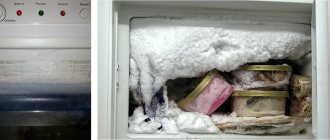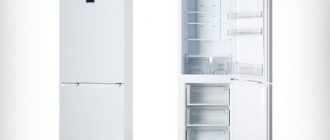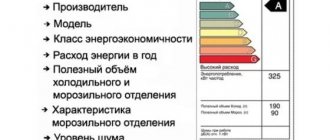Causes of fan failure in the LG No Frost refrigerator
Let us highlight several main reasons that can lead to fan failure:
Long absence of defrosting. If the refrigerator has not been defrosted for more than 5 years, then excess moisture will form inside it. It leads to ice freezing on the fan, as well as its formation on the rear wall covering the evaporator. In this case, you can solve the problem yourself; to do this, you need to defrost the refrigerator. Unplug it and leave the doors slightly open. Give it a day to defrost. After this, wipe the refrigerator, removing water from it.
Ice freezing on the fan blades. In this case, it may simply jam. There is also a high risk of winding burnout. Then defrosting the refrigerator will be ineffective. You will need to call a technician who will confirm the breakdown and be able to replace the failed part.
If you have special skills, you can replace the fan yourself. To do this, you need to disconnect the refrigerator from the power supply and provide access to the fan and evaporator. In some models they are located at the back wall of the freezer. Next, you will need to unscrew the screws holding the cover and remove the fan. After diagnosing it using a tester, you can confirm the assumption that it is broken or refute it. All that remains is to rewrite the fan model, buy the same one and install it. The work is not difficult, but requires skills. If they are not, it is better to entrust the repair to a professional.
Failure may be due to:
- Rare defrosting, which leads to accumulation of ice on the blades;
- Malfunction of the compressor or control board, resulting in freezing and icing of the blades;
- Lack of lubrication in the bearings, which is caused by too powerful air flows;
- Burnout of contacts due to power surges;
- Natural wear and tear of moving elements.
Types of fans and their problems in the LG No Frost refrigerator
Each refrigerator model is unique in its own way. The location of fasteners and technical components is different, as is the free volume allocated for fan installation. Choose between two types: axial and centrifugal.
Axial models are the most common. Their principle is simple: an impeller with blades is placed on the electric motor shaft, which push air along this very shaft. Their advantages include ease of operation and high maintainability.
Centrifugal fans, also called radial fans, are used a little less frequently. They do not have any special advantages or disadvantages over axial ones. The main difference is in the dimensions and shape of the housing; they are installed where the use of an axial one is impossible.
What other problems could the fans in the LG No Frost refrigerator have?
Electric motor malfunction resulting from power surges or other reasons. “Cure” by replacement. It is necessary to distinguish between breakdowns of the motor itself and the control unit. Failure of the latter also leads to a stop of rotation. Accurate diagnostics can be carried out by supplying electricity to the fan, bypassing the control circuits. Be sure to make sure that the parameters of the supplied current correspond to those indicated on the motor housing.
Intense air flow often causes the lubricant in the motor bearings to dry out. During periodic inspection, they should be inspected and, if necessary, lubricants should be added.
For the sake of cheapness, the impellers are made of plastic, which becomes more fragile in the cold. If the heating element fails, the blades begin to hit the ice, producing a characteristic knocking sound when operating. If the ice crust is too thick, the blades may crack or fall off. Spare impellers can be easily found in specialized stores.
Refrigerator fan won't turn off
If the refrigerator fan does not turn off and runs continuously, there are few reasons. The appliance does not stop because the compressor is running. This will happen if there is no command to stop or the chamber is warm. There are several reasons:
- the thermostat or air sensor has deteriorated;
- there is a freon leak or the capillary tube is clogged;
- the connection of the door to the circuit is broken.
However, the fan can contribute to malfunctions - the blades are frozen and rotate poorly, performance and pressure are reduced.
Refrigerator fan hums
If the fan rattles, hums, or crackles, there may be several reasons. At times, the system requires not only defrosting, but also the motor bearings need to be lubricated. When it dries out, an unpleasant grinding and humming noise is heard. It is not the fan itself that is humming, but the entire refrigerator due to vibrations. It is necessary to inspect the shock absorbers of the unit and reduce contact with the cabinet wall.
Another reason for increased noise is due to poor defrosting or a clogged drain hole. Ice accumulates on the radiator in the cooling chamber. The cracks between the tubes gradually become overgrown with frost, the block grows and pinches the blades. The motor hums before burning out under heavy load. I urgently need to defrost the refrigerator. After turning on the device, you need to make sure that the compressor is working correctly, the defrost is turned on, and the fan blades are spinning.
Why the fan in the LG No Frost refrigerator may not work
First of all, you need to look for icing on the freezer evaporator; this is one of the most important reasons for the lack of cold air blowing into the refrigerator compartment. Icing of the evaporator entails ice freezing on the fan blades. I will not delve into the operation of the defrosting system of such refrigerators, since this topic is very large and we can talk about it for a long time, but if you are very interested in this, you can read this article, it talks about the defrosting system in some detail. Now let's go back to our fan and continue the topic. Icing of the wind blower impeller is rare; more often the air duct channels simply freeze and, as a result, cold circulation occurs only in the freezer compartment. If you get to the evaporator and see that there is no ice and the impeller is spinning normally, then you need to further check the serviceability of the fan. Before examining in detail the issue that concerns the breakdown of the fan and everything connected with it, I recommend watching a video that shows how to get to this part and to the evaporator
Video: LG No Frost refrigerator repair
Now that we know where the fan is located in the No Frost refrigerator, we can begin to diagnose problems associated with this spare part. To do this, I have selected several of the most popular questions that are heard on my YouTube channel, I think thanks to my answers, you will find a solution to your question
Help me solve the problem, I have an El G refrigerator with the No Frost system. In general, the refrigerator compartment stopped working normally, and the food in the freezer seemed to be frozen. The following happens: from time to time the air stops blowing through the air ducts, if you open the freezer, pull out one drawer and lightly knock on the back cover, the fan starts, everything returns to normal. Question: fan or defrost sensor? There is no ice, the defrost works fine, but the fan obviously slows down sometimes. I think what should I change?
I don't think any sensor is faulty. After all, as you said, there is no icing on the evaporator. I think the problem is in the fan, don't write off just changing it. The fact is that in Elji and Samsung, this is a sore spot, the plastic is not strong, in general, when the defrost is working, this plastic leads a little, this concerns the impeller and the cage itself that holds the fan. It's easy to fix, you need to remove the fan, turn the impeller, only in different positions, that is, sideways, lying down, and so on. If the feathers are very close to the body, take them and trim them. I think it's not difficult. There is another reason why the fan does not work: the freezer evaporator is frozen (I think this is not your case). Also, the fan in No Frost may not spin due to wear on the pulley, as a result there is play and the fan feathers begin to touch the housing, again you just need to cut off the wings of the impeller
I got to the freezing evaporator and the fan, and indeed when I turn it, in one area it catches on the housing. I cut off the blades and at the same time lubricated the bushings in which the anchor goes. To be honest, I saw fans only with bearings, but there was some kind of incomprehensible design, I wanted to change the bushing, but as it turned out, it was impossible to machine it, it was very small and the turner said that it had to be machined from a certain material. I wouldn’t bother with this issue, but the fact is that there is quite a noticeable play on the bushing, which is closer to the blades. I don’t know what to do
It’s better, of course, to buy a new fan; at No Frost it will be inexpensive, and as long as trimming the impeller will contribute to its normal operation. It seems like you did everything right, except for one thing - these wind blowers cannot be lubricated. The fact is that thanks to the copper-graphite bushing, the working part of the shaft is lubricated by itself. In general, you need to take everything back apart and wipe off your grease well, it shouldn’t be there. Take alcohol or gasoline, but be careful not to get it on the rubber parts of this part.
The fan in the refrigerator does not work, reasons.
Fan- a mandatory element in the design of refrigerators with the No-Frost automatic defrosting system, and is also installed in many models without No-Frost.
The fan is responsible for regulating the temperature in the chambers and forces forced circulation of cold air throughout the entire volume of the refrigerating chamber. It is usually installed with a weeping evaporator located in the freezer compartment (can be installed either in the upper or lower part of the chamber). The operation of the fan is controlled by a temperature sensor with a sensitive element in the MK. When the temperature in the freezer reaches an extremely low level, the fan turns on automatically. It is possible that a thermostat is installed to control the fan only.
In refrigerators without a No-Frost system, this element is installed in the refrigerator compartment and has a power button that is manually controlled. Many owners of such refrigerators note difficulty in starting the fan, when during normal operation of the refrigerator this element does not start.
In refrigerators with No Frost, the fan has to work constantly, so this element quickly fails
(according to experts, this is one of the significant disadvantages of refrigerators with automatic defrosting).
Users of modern refrigerators note that after a certain period of operation the fan in the refrigerator does not work
. As a result, the temperature regime of the chambers and the entire cooling system is disrupted. The freezer works like a refrigerator, and the temperature in the cold room is very high.
In addition, some fans are quite noisy.
and non-stop, which also indicates a possible breakdown in the cooling system.
When the fan operates non-stop, intense freezing occurs on the radiator (which acts as an evaporator in a system with No Frost). Thus, air does not pass through it, and the temperature in the chambers rises.
A fan malfunction may also be associated with a failure of the sensors responsible for the operation of this element: contacts are burned out, the start relay does not operate, etc. It is worth additionally checking the performance of the motor-compressor and all its components.
For a quick and high-quality solution to a breakdown, it is better to contact specialists and not try to look for the cause on your own, resorting to the advice of forums and friends. It’s better to get qualified help once than to correct your own mistakes and endlessly repair the refrigerator.
Checking the fan in the LG No Frost refrigerator
The fan is an important component in the refrigerator operating system. It is built into the electrical circuit of the device and is electronically controlled. Naturally, during operation, the refrigerator cooling fan creates a certain noise from the rotation of its blades. On average, the volume is estimated at 35-45 dB. The fan operates simultaneously with the compressor, transferring cooled air from the evaporator to the refrigeration chamber itself.
If the radiator does not completely thaw in time, the ice actively builds up and the fan begins to make a strong crackling sound and squeak when rotating. Increased noise naturally attracts attention. To check whether the fan is working, simply place your hand near it while the compressor is running.
For example, we can consider a Bosch refrigerator with the No Frost system. The photo shows a two-compressor refrigerator. In this case, any problems with the operation of the fan are displayed on a special display in the form of a conditional error code. The most common malfunctions are those related to the control system. To solve the problem, specialists call all contacts and find a broken element, which must subsequently be replaced.
No voltage on the fan in the LG No Frost refrigerator
First, let's determine what is responsible for the operation of the fan on No Frost and how this part is turned on in general. The first thing you need to understand is that 220 volts are supplied to this part and to check it, just apply 220 to it and see whether the fan will work or not. If the startup does not occur, then you need to check those components that control this spare part. In such units there are only 3 parts that are responsible for supplying voltage to this unit
- Power button and light switch off → You've probably noticed that when the door opens, the fan stops working, this is done so that the refrigerator pumps in as little warm air as possible. It often happens that this button burns out, especially for LG No Frost refrigerators, which have a timer and thermostat, that is, with mechanical control. On refrigeration units with electronic control, everything is a little different, I will talk about this in the next paragraph
- Relay on the control unit → This point applies more to LG No Frost, which have electronic control. In general, on the control unit there are switches that control the operation of the fan and motor, and these are the ones that sometimes fail. In this case, the fan operation is controlled by a light button and a relay on the control module. The button in such units is usually located between two chambers and it opens and closes using a magnet located on the refrigerator door
- Evaporator temperature sensor → This item also largely concerns electronic control. As long as there is no signal from the defrost sensor or the evaporator temperature sensor that the required temperature has appeared on the walls of the freezer to turn on the fan, the control unit will not provide voltage to the wind blower
Well, now let's look at the questions that are most often heard on my channel and relate specifically to voltage, that is, why the fan does not receive 220 volts
I have an old No Frost, it has worked faithfully for more than 10 years, but lately the fan has been difficult to turn on. It happens that it stops during operation, that is, the refrigerator is running, the motor is humming, but the impeller is not spinning. If you open the door to the refrigerator compartment and then close it, the fan turns on. What could be the reason
I have already mentioned the reason above, most likely the light switch is faulty, you need to replace it. Please note that it is not simple, this button works in both directions, that is, it has not two contacts, but four. One pair of contacts turns on the light, and the other pair turns on the fan. When you close the door, the button switches the current from the light bulb to the fan
Please tell me how the fan should work, for some reason it constantly makes noise for me, even when the compressor is not working, sometimes it turns off, but this happens very rarely. Does he really have to oil it all the time? I have an electronically controlled refrigerator
The culprit for this behavior may be the relay on the control module, sometimes it stupidly sticks, the temperature sensor of the freezer evaporator could also be covered, it’s 50/50, either the sensor or the relay. On electronically controlled refrigerators, the fan turns off a few seconds after the motor is turned off. The signal to turn off is given by the evaporator temperature sensor; it should show the control module that the temperature of the freezer and the freezer compartment are approximately the same. After turning on the engine, the fan does not start immediately; again, it will start working only when the evaporator temperature sensor shows that the minimum cold value has been reached in the freezer. In principle, I talked about all the most basic breakdowns associated with the operation of the fan, I think this will make it easier for you to repair the LG No Frost refrigerator with your own hands, the main thing here is to make a correct diagnosis of the breakdown, if you find the cause, it won’t be difficult even for an ordinary person to fix it
Purpose of ventilation
A fan is used to regulate the temperature and move air flow in the refrigeration chambers. Typically, this device is installed next to the evaporator, mounted along the rear wall of the compartment. To control the operation of the fan, a special temperature sensor with a sensitive element in the freezer is provided. When the temperature drops to the maximum threshold, the ventilation system turns on automatically. Some refrigerator models require the installation of a thermostat to control the fan. In refrigeration equipment without a NO Frost system, this component is started manually by pressing a button.
Repair of fans in LG No Frost refrigerator
Independent work on replacing, repairing or servicing fans and other components of the No Frost system requires knowledge of electrical engineering, the principle of operation of the refrigerator and the availability of special tools. The best solution would be to call a specialist, because independent maintenance can lead to loss of warranty.
If this doesn’t bother you, you first need to gain access to the evaporator chamber. It is usually located just under the back wall and is easy to get to. Make sure the refrigerator is unplugged. If the fan in the refrigerator does not work, conduct an external inspection. Look for signs of mechanical failure or melted sections of wiring. You can remove the impeller by unscrewing the fastening bolts. Since you're so close, renew the lubricant.
If the cause of the breakdown is in the motor itself, carefully remove it and find a replacement. It will cost less than repairing the old one. Assembly is carried out in reverse order. Wire connection diagrams must be sketched out so as not to confuse anything.
Is it possible to repair the cooler yourself?
You can, if you have experience in this field, you know the design of refrigerators and have special tools. In all other cases, it is better to contact a workshop or service center.
If you still want to take a risk, use these instructions:
- Unplug the equipment from the outlet.
- Locate the evaporator chamber - it is usually located on the back wall.
- Inspect all fan parts - look for mechanical damage or burnt wiring.
- Unscrew the impeller fasteners. To be on the safe side, replace the lubricant.
- If the problem is with the motor, remove it and replace it with a new one.
The role of the fan in the operation of the LG No Frost refrigerator
The entire system consists of a so-called cooling chamber, where the evaporator, fan and defrost heating element are located. The air taken from the working space is driven by the force of the impeller through the evaporator fins, on which the moisture settles in the form of droplets and immediately freezes. Then the dry and cooled air is pushed through the air ducts back into the chambers.
Moisture, gradually freezing on the evaporator, forms a layer of frost. When its thickness reaches a certain point, heat exchange between the refrigerant and air becomes almost impossible. Freon does not evaporate completely, which threatens the refrigerator’s operation, even to the point of complete failure. To prevent this, artificial defrosting was provided: at the command of the timer, the heating element is turned on, which quickly heats and thaws the evaporator. In this case, the water is discharged through the drain to a tray, which is placed above the compressor, where it evaporates.
As you can see, without a fan the operation of the ventilation system is impossible. If it breaks down, air stops circulating through the chambers, although the compressor is still working. This leads to excessive load on the mechanisms and to the fact that the refrigerator stops cooling food.
To cool the air masses in the refrigerator compartment, warm air is used, which passes through the evaporator using the movement of the fan impeller. Thus, the air becomes cold and is evenly distributed throughout the volume of the refrigerating chamber.
When the electric motor stops, the heating element turns on, which leads to the thawing of the ice and the flow of moisture into the built-in tray.
Depending on the refrigerator model, air flow can be supplied:
- From the side walls;
- From the top of the compartment;
- Separately for each shelf.
- There are also models that have two pairs of independent cooling circuits.
Fan layout diagrams for LG No Frost refrigerator
Often, refrigerator manufacturers create “new” paths through which air enters the chambers, calling them a fancy name and patenting them. In practice, there are several typical schemes, and all the diversity is created by varying their parameters. Below are the patterns that are most common:
- Air Shower. Translated as “air shower”. From the name it is clear that the air flows are directed from the ceiling of the chamber.
- Cool Front Shower. The air duct pipes are routed to the walls and door of the refrigerator; air is supplied to the food shelves from the sides.
- The Surround Cool scheme is a hybrid of the previous two: flows are directed from all sides.
- Multi-Flow involves several independent air ducts. If the output flows intersect, then such a system is called X-Flow.
- The Twin Fan system stands out. These are two paired systems that ensure autonomous operation of the refrigeration and freezer compartments. Each is equipped with its own fan and thermostat.
Video: fan repair in the No Frost system
I recommend to read:
- The refrigerating chamber in the LG No Frost refrigerator does not work - The difference between a refrigerator with a full No Frost system (I advise you to read the article about the design of the LG No Frost refrigerator) is that the cooling of the chambers is carried out using a non-contact method,…
- Replacing the Atlant refrigerator fan - A non-working fan is a common malfunction that requires an immediate solution, because... could lead to more serious and costly damage...
- The refrigerator works, but does not cool - reasons - When everyday life is smooth, nothing causes discomfort. Every apartment has types of equipment that, although difficult, can be done without. But, as soon as the refrigerator fails,...
- The refrigerator does not cool, but the freezer works: what needs to be done - Sometimes, during long-term operation, it happens that the freezer works, but the refrigerator does not or cools very weakly. In the main refrigerator compartment…
- The defrost in the Atlant refrigerator does not work - Does your refrigerator need repair? The equipment served for several years without breakdowns, but the defrosting system stopped working? Of course, we can’t continue with such a malfunction...
- LG refrigerator - the display does not work - What to do if the display in your refrigerator does not work? Let's look at the possible causes of the breakdown. But first, we note that this does not apply to breakdowns: The screen “goes dark”...
- Miele refrigerator - the refrigerator compartment does not work - If the refrigerator compartment does not work, this causes the following troubles: Products spoil without proper cooling, Household appliances work with increased...
Leave your phone number and we will call you back in 5 minutes
Basic and typical malfunctions of refrigerators:
- — No cooling
- — Increased noise, knocking, rattling
- — A current is felt when touching metal parts of the refrigerator
- — The snow coat is growing quickly
- — Odors in the chamber, unpleasant taste in food
- — Poor cooling of food
- — Long start of the motor-compressor
- — Triggering of the protective relay
- — Excessively high or low voltage in the network.
- — The motor-compressor works without shutdowns
The design features of modern refrigerators include a fan. This is a mandatory element in refrigeration equipment with automatic defrosting, which is also installed in many models without a NO Frost system.










